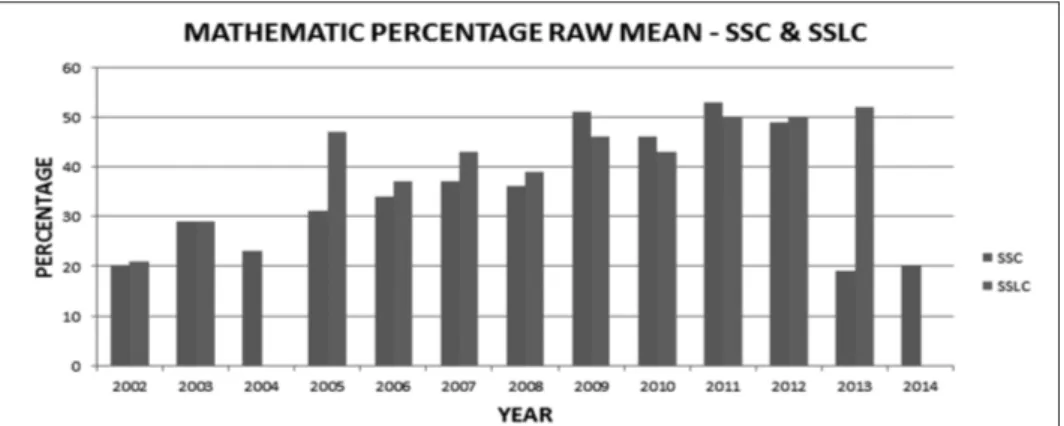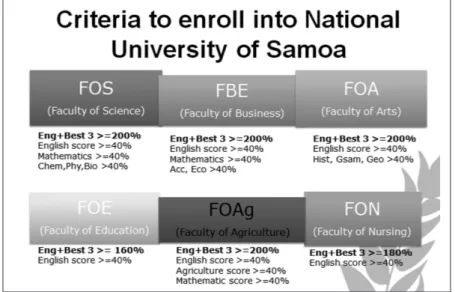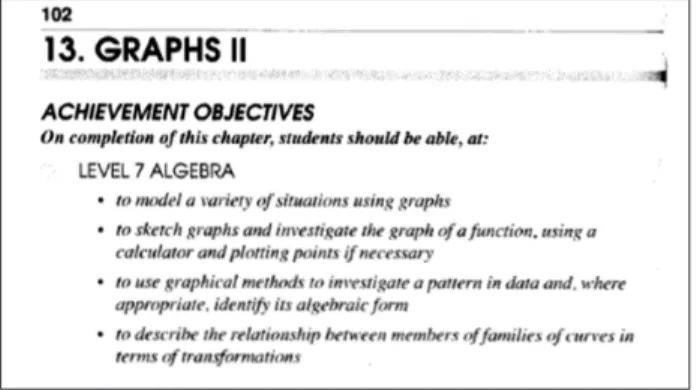Issues that Hinder the Development of
Mathematics Education in Samoa
John Paul LEAUANAE
NUE Journal of International Educational Cooperation, Volume 11, 65-71, 2017
Study Note
Naruto University of Education
Abstract
Mathematic competency in Samoa has been low for more than 20 years now. It is considered the lowest achieving subject in examinations, 40% of students receiving 30% marks or lower in National Examinations. Students entering into university for advanced studies in Mathematics are inadequately prepared for further studies in Calculus and Linear Algebra. This is due to the lack of substantial understanding in fundamental principles of Mathematics. This article provides an overview on the quality of teaching Mathematics in which it directly impacts student learning in primary and secondary level education. Also the non-alignment between the curriculum and the textbook indirectly affects student who are learning mathematics. Also it briefl y explains examiners and their lack of understanding of the current situation of what is being taught to students, because there is a misunderstanding between what is perceived to be taught and what it is actually being taught to students.
Keywords: Samoa, Mathematics
1. Introduction
Samoa is an island located in the Polynesian region of the South Pacifi c Ocean with a population of 187,820 on a land area of 2,944sq km (
) comprising the two main islands of Upolu and Savaii and eight small islands. The education sector consists of: government and non-government schools (primary and secondary); early childhood education; post school education and training; and Ministry of Education Sports and Culture (MESC). Ministry of Education is guided by their mission which is
The ministry s responsibilities include school planning, policy formulation and regulation of education in Samoa. This mission or theme is the groundwork of school development programs in Samoa. The sole objective is to increase
and broaden access to education, ranging from Early Childhood Education to Universities. Despite the Ministries eff ort to improve education, the mathematic performance of students in higher-level examination is constantly low. Mathematics subject is taught from primary to secondary and it is the leading issue facing the education sector at present. Students mathematics level drops drastically, as they reach secondary schools and this problem has continued for the past 20 years. It is an issue that demands the attention of the Ministry of Education. It needs to undergo reforms and to upgrade to try resolving this issue. One major reform started in 2012 and it was fi rst implemented in 2014, when Pacifi c Senior Secondary Certifi cate (PSSC) which was administered by the Secretariat of the Pacifi c Board for Education Assessment (SPBEA) was replaced by Samoa Secondary Leaving Certifi cate (SSLC). The development and the localization of external assessment components that is, examinations
have currently been administered in a Samoa context since 2014. Even with these reforms, there was not much improvement to the credibility of mathematics examination. It is believed the quality of learning depends on the quality of the teaching inside the classroom. Therefore, in order to improve the competency level of students in mathematics, teaching of mathematics needs to be improved fi rst. Teacher must be equipped with both knowledge about the contents and pedagogical in order to boost confi dence in teaching mathematics.
2. Background
The fi gure below shows two graphs the current progression rate of students in secondary schools
and the transition rate of students to university level respectively. In the fi rst graph (see fi gure 1) the low progression rate for Year 11 is due to students skipping a grade from Year 10 to Year 12. However In Year 12 and Year 13, the students are required to take the national examination which resulted in, the drop in progression rate for Year 13. About 30% of students tend to fail the examination in Year 12 comparatively, about 40% tend to fail the Year 13 examination. From those who failed, half of them will repeat a year in order to continue studies while the other half will drop out of school like any other country, where various educational issues exist. The Ministry of Education Sports and Culture is continuously seeking for a solution.
The main issue this paper will focus on is the mathematics competency of schools in Samoa. The status of mathematics education of schools in Samoa is a major concern for University level. In the secondary level, the students are not adequately prepared for the next step of mathematics at the University. The foundation of mathematics and its principles are not properly acquired, learned and nurtured at the appropriate age therefore; it causes a ripple eff ect throughout their academic life. This issue was not fully revealed until the Ministry of Education localized the national examination in the year 2014, the shift from Pacifi c Senior Secondary Certifi cate to Samoa School Leaving Certifi cate. This new reform of localizing the examination, involves the modifi cation and unpacking of the current syllabus and introducing the SOLO taxonomy to analyze student s answers in the examination paper. Structure of Observed Learning Outcomes (SOLO) Taxonomy provides a
simple, reliable and robust model for the three levels of understanding-surface, deep and conceptual. (Biggs and Collis, 1982). From this reform, it has revealed students actual mathematics knowledge. In Figure 2, the graph illustrates the average percentages of national examination, namely the Year 12 Samoa School Certifi cate (SSC) and Year 13 Samoa School Leaving Certifi cate (SSLC) for Mathematics from 2002-2014. These are the last two years of secondary schools. The results shown, clearly confi rmed that the achievements of mathematics in students are considerably low as their academic life reaches the fi nal stage of college. The problem is constantly and rapidly increasing throughout the years resulting in more and more students loathing mathematics subject in secondary schools. Due to the localization of the national examination, results for SSLC shown in fi gure 3 was recorded and analyzed using the SOLO Figure 1. Progression rate. (Source: Education Statistic Digest, 2016, p. 52)
Taxonomy model. About 96% of the students achieved beginners level in Mathematics, 3% in Achieved level
and 1% in Merit level. No student achieved Excellent level since the introduction of the SOLO Taxonomy.
The SOLO taxonomy model can help identify the core factor of students problem in mathematics. The gap lies in the students ability to use and apply their previous knowledge to understand new knowledge. The students learning capacity has not been well taught in order to link and connect previously learned knowledge to help solve new knowledge. It is shown by the SOLO taxonomy analysis of the SSLC examination that almost all the children s level are at the beginners level, in other words, students knowledge are still at their crude state. It is a huge challenge for the MESC to fi nd a solution and this clearly justifi es the ongoing state of Samoa educational reforms.
3. Teachers lack the competency to teach mathematics
Teachers are one of the most important resources,
he/she is expected to deliver and educate to the best of their ability. Students respect and trust their teachers therefore, whatever the teacher will teach they will believe and consider it to be accurate. The problem occurs when the ability or the capability of the teacher is questionable. It is a great concern and a problem if most teachers that teach mathematics in both primary and secondary level are not profi cient to teach. In primary level schools, from Year 1 to Year 6 only one teacher teaches all the subjects. Most teachers are forced to teach mathematics, and this is an issue by itself because they do not have the capability to fully understand and educate mathematical concepts. One of the main reasons being is, students who disliked mathematics when they were in school, have now become primary teachers. Unfortunately, they have no choice but to teach mathematics and Figure 2. SSC and SSLC Mathematics at-risk percentage (source: Education Statistic Digest, 2016, p. 51)
consequently they will inevitably teach mathematical contents according to their level of understanding. These teachers will try and learn mathematics just by memorizing how to calculate and follow the pattern of calculation without any knowledge of mathematical concepts or why it is done that way. For example, in one of my classroom experiences as shown in Figure 4 below clearly demonstrates how teachers without any background knowledge and understanding of mathematics interpret and teach.
Teachers follow the pattern of adding fractions which deals with how to fi nd the lowest common denominator therefore, applied the same method when two fractions are being multiplied. It is a great misconception that misleads and harms the understanding and knowledge development of students in mathematics. A diagnostic research was conducted to Primary School teachers to fi nd out common misconception among teachers who will be teaching in the fi eld of mathematics. ( ). About 30% of teachers showed misconceptions with measurements as the highest. Teachers play a vital role in class therefore; they should be the number one priority and focus for the Ministry of Education
Sports and Culture (MESC) in Samoa. The ever growing number of primary level teachers who have little or no knowledge of how to teach mathematics is constantly increasing and it has become a major threat to mathematics and its future. This problem applies and aff ects secondary level teachers as well. Moreover, there is a huge dropped in the number of teachers who teach Secondary level mathematics, which leads to schools being forced to employ anyone with little or no background in mathematics and/ or without considering their qualifi cations. (
) For example, an Accounting teacher can teach mathematics because accounting involves calculations similarly, a chemistry teacher can teach mathematics because Chemistry has formulas. This kind of approach and practice is being used by school principals and executives due to the lack of qualifi ed and capable teachers in mathematics.
4. Teacher training college standard needs improvement
Countries with a better education system have high standards for those who want to become a teacher. The best students are chosen to become teachers, why teachers are well respected by society. In Samoa, it is a completely diff erent logic, to enroll in a Teacher Training College; the most important subject is English. The National University of Samoa is also the only local university in Samoa that consists of six faculties and for a student to enroll in each faculty, there are certain criteria that needs to be met. Figure 4. Year 4 calculation error
Source: Author’s experience
Figure 5. Enrolment criteria into National University of Samoa, Source: National University of Samoa calendar, 2016, p. 100)
The National University of Samoa places more emphasis on higher standards in Faculty of Science, Business, Arts and Agriculture with an aggregate mark of 200% or more with specifi c required marks from associate subjects. However, for a student to enroll in the Faculty of Education, an aggregate mark of 160% is enough with more emphasis on English marks only. Therefore, students who are mostly enrolled in the Faculty of Education are considered not academically oriented and thus cannot make it to other faculties. The Faculty of Education is becoming a haven or a fall back plan for students who want to leave college and start university.
5. The school syllabus is not aligned with the textbook used in the classroom
The second most important resource in a classroom is the materials such as textbooks. Textbook as defi ned
by Oxford dictionary;
The textbook assists the teacher during his/her teachings and serve as a teaching material, but using an obsolete textbook goes against the above mentioned defi nition. The mathematics textbook, published in the year 2004, was aligned with the curriculum used at that time. In Samoa, however, throughout the years there have been some changes in the curriculum with some topics being added or omitted. These changes were not eff ective immediately but over the years the changes became bigger and later resulted in dire consequences. For example, Algebra-graphs, in the syllabus is mentioned to factorize the cubic expression using the factor theorem, but in the textbook (
) cubic is plotted using plotting points according to the objective of the chapter, as shown in Table 1 below.
In Trigonometry, the syllabus requires students to solve trigonometric equation using the reciprocal functions which are Secant, Cosecant and Cotangent, in the textbook; the only identities mentioned were Sine, Cosine and Tangent in addition it was mentioned as an Investigation problem but not in class.
One of the major changes in the curriculum was when the International examination for senior levels was localized. As a result, in 2014 Samoa s University entrance examination for Year 13 became localized which made some huge changes to the curriculum and also of how the examination was written. Even though with all these changes being occurred teachers were still using the same textbook. Unfortunately, about 40% of the textbook contents are now obsolete and no longer in practice in the curriculum. Therefore, the responsibility to seek extra help and assistance now falls on the mathematics teacher. For instance, the commonly used textbook on addition in the Samoan classroom are textbooks from New Zealand and America. For a Year 13 teacher about 2 extra textbooks is needed to be used in order to fully cover the contents of the curriculum. However, not Figure 6. Textbook content-Chapter objective
Source: Year 13 Mathematics Textbook, 2004, p. 102
Table 1. Syllabus content-Objectives Source: Syllabus Unpacking, 2017
all schools are fortunate to fi nd additional textbooks hence, some topics in the curriculum are not covered in the academic year.
6. Examiners are not familiar with the syllabus At the end of each year, the Year 12 and Year 13 students sit a National Examination. This examination determines the student s ability to proceed to the next level. Year 12 examination is called Samoa School Certifi cate (SSC) and it is a precedence certifi cate to enter Year 13. Samoa School Leaving Certifi cate (SSLC) is the Year 13 examination used as an entry point into university. However both examinations are controlled by the Ministry of Education Sports and Culture (MESC). Finding examiners is a responsibility of MESC and one of the policies to become an examiner states; a teacher currently teaching in Primary or Secondary school cannot become an SSC or SSLC examiner. The policy was made to minimize biased in setting the exam paper, but it also poses a problem. Examiners are now been recruited from Professors and Lecturers of the National University of Samoa. To be an examiner they must be familiar with or able to read the curriculum in order to write the exam paper. However, most of these examiners have never taught in Primary or Secondary schools, they have no background knowledge or experience on how to teach the curriculum. As a result there is a high possibility that they may create examination questions that are outside the scope of the curriculum and outside of the student s level of understanding. As mentioned by Rev. Vavatau, Director of Congregational Christian Church Schools in Samoa, The content of each question is stated in the curriculum however the actual question and level of diffi culty found in exam were of Foundation level not Year 13
. In addition Chris Hazelman, director of Catholic Schools in Samoa, mentioned in the Samoa Observer Newspaper After close analysis from teachers in the Catholic and Private systems I can say that there are close to 40 questions that should not have been in the exam. This is unacceptable . This supports that there is a diff erence in point of views or interpretations of the curriculum between those who uses the curriculum daily to teach the subject and from those who just read the curriculum in order to write the examination paper.
7. Conclusion and Recommendation
Mathematic results can be improved if the quality of teaching in the classroom improves. Teachers are the most important resource in classrooms; the change should start from teachers. Teachers need to participate in professional development activities on a regular basis to refresh, upgrade and review their outlook in teaching mathematics. In addition, they should have the opportunity to share similar concerns and experiences with other colleagues or fellow mathematics teachers in Samoa; it could contribute positively to teachers own self-esteem and confi dence as educators. Hence, there is a great urgency for the MESC and NUS to work collaboratively in developing guidelines and implementing strategies whereby the two institutions can fully utilize the expertise available locally in Samoa, to develop professional development activities to impact mathematics learning in local classrooms. MESC should also take a closer look and needs to improve on the selection criteria of becoming a teacher. The government s priority must be put on education focusing on mathematics.
8. References
Biggs, J. B., & Collis, K. F. (1982).
. New York: Academic Press.
Ministry of Education Sports and Culture, (2016), Education Statistical Digest, Accessed 16th November
2017, Pg 51-54
<Available at: http://mesc. gov. ws/images/Tala/ Education_Statistical_Digest_2016. pdf>
Ministry of Education Sports and Culture. (2015). Strategic Policies and Plan July 6th 2006-June 2015,
Accessed 16th November 2017, Pg 21
<Available at: http://www. mesc. gov. ws/images/ pdfs/spp_web. pdf>
Fuata I et al. (2007). Primary Student Teachers Diagnosed Mathematical Competence in Semester One of their Students, pp. 89.
<Available at: https://www. merga. net. au/documents/ RP22007. pdf>
Writer, S. (2016, January, 14), Transparency needed. Samoa Observer.
<Available at: http://www. samoaobserver. ws/en/ 14_01_2016/local/1211/Transparency-needed.
htm>
The National University of Samoa. (2016). The National University of Samoa Calender. Samoa: National University of Samoa.
Ministry of Education Sports and Culture. (2004). Year 13 Mathematics. Auckland: ESA Publications https://www.collinsdictionary.com/dictionary/


